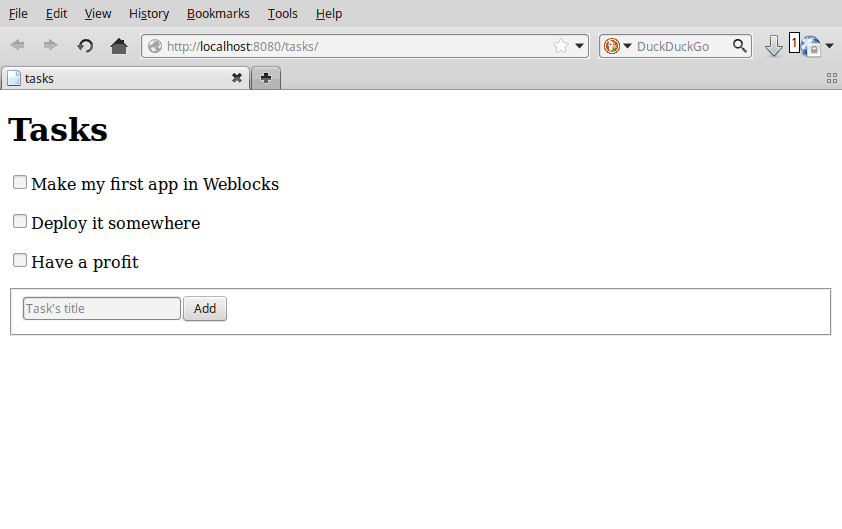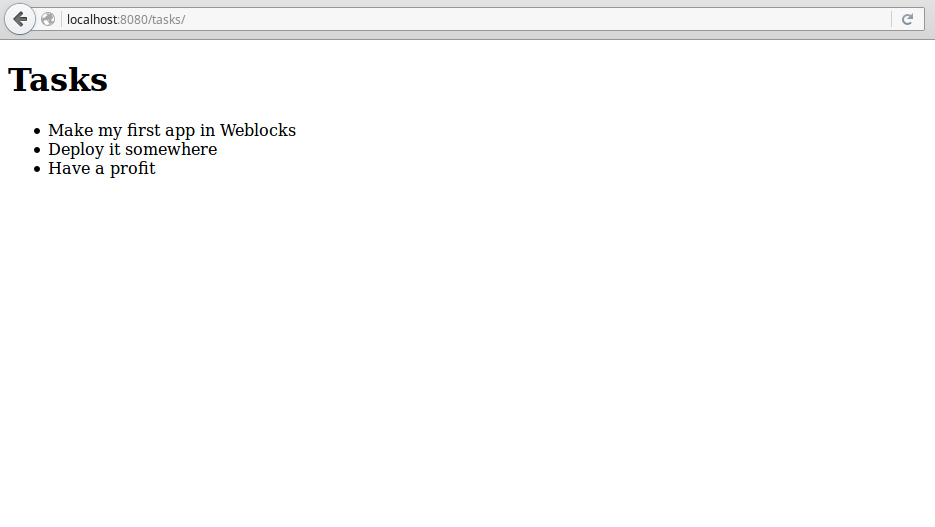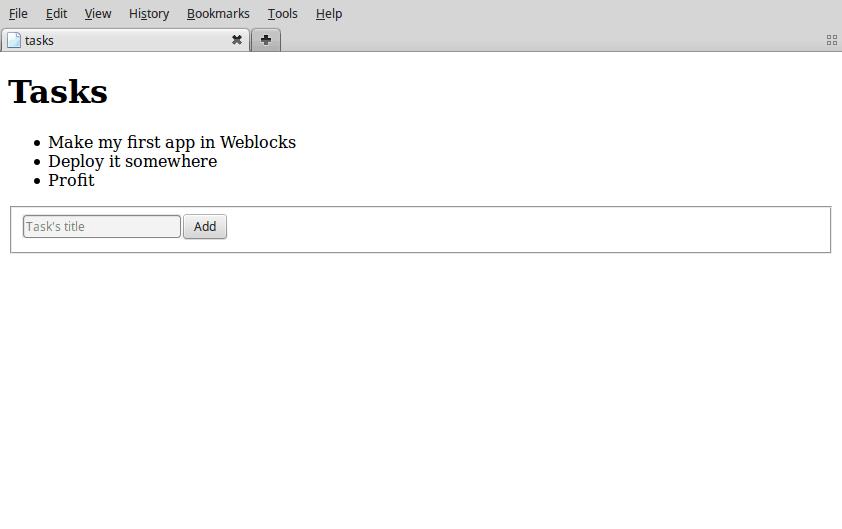Quickstart¶
Warning
This version of Weblocks is not in Quicklisp yet. To
install it you need to clone the repository somewhere where
ASDF will find it, for example, to the ~/common-lisp/ directory.
You also need to clone weblocks-ui.
See also
You can also install the Ultralisp Quicklisp distribution where all Weblocks-related libraries are present and up to date.
Load weblocks and create a package for a sandbox:
CL-USER> (ql-dist:install-dist "http://dist.ultralisp.org/"
:prompt nil)
CL-USER> (ql:quickload '(:weblocks :weblocks-ui :find-port))
CL-USER> (defpackage todo
(:use #:cl
#:weblocks-ui/form
#:weblocks/html)
(:import-from #:weblocks/widget
#:render
#:update
#:defwidget)
(:import-from #:weblocks/actions
#:make-js-action)
(:import-from #:weblocks/app
#:defapp))
#<PACKAGE "TODO">
CL-USER> (in-package todo)
#<PACKAGE "TODO">
Now, create an application:
TODO> (defapp tasks)
By default, the name of the app defines the url where it is
accessible. Here, the “tasks” app will be accessible under
http://localhost:40000/tasks. We can change it with the
:prefix argument:
TODO> (defapp tasks
:prefix "/")
Now our app runs under the root url.
TODO> (weblocks/debug:on)
TODO> (defvar *port* (find-port:find-port))
TODO> (weblocks/server:start :port *port*)
<INFO> [19:41:00] weblocks/server server.lisp (start) -
Starting weblocks WEBLOCKS/SERVER::PORT: 40000
WEBLOCKS/SERVER::SERVER-TYPE: :HUNCHENTOOT DEBUG: T
<INFO> [19:41:00] weblocks/server server.lisp (start-server) -
Starting webserver on WEBLOCKS/SERVER::INTERFACE: "localhost"
WEBLOCKS/SERVER::PORT: 40000 DEBUG: T
#<SERVER port=40000 running>
(NIL)
Open http://localhost:40000/tasks/ in your browser (double check the port) and you’ll see a text like that:
No weblocks/session:init method defined.
Please define a method weblocks.session:init to initialize a session.
It could be something simple, like this one:
(defmethod weblocks/session:init ((app tasks))
"Hello world!")
Read more in the documentaion.
It means that you didn’t write any code for your application. Let’s do it now and make an application which outputs a list of tasks.
In the end, we’ll build the mandatory TODO-list app:

The Task widget¶
TODO> (defwidget task ()
((title
:initarg :title
:accessor title)
(done
:initarg :done
:initform nil
:accessor done)))
This code defines a task widget, the building block of our
application. defwidget is similar to Common Lisp’s defclass,
in fact it is only a wrapper around it. It takes a name, a list of
super-classes (here ()) and a list of slot definitions.
We can create a task with make-instance:
TODO> (defvar *task-1* (make-instance 'task :title "Make my first Weblocks app"))
TODO> *task-1*
#<TASK {1005406F33}>
Above, :title is the initarg, and since we didn’t give a :done
argument, it will be instanciated to its :initform, which is nil.
We defined accessors for both slots, so we can read and set them easily:
TODO> (title *task-1*)
"Make my first Weblocks app"
TODO> (done *TASK-1*)
NIL
TODO> (setf (done *TASK-1*) t)
T
We define a constructor for our task:
TODO> (defun make-task (title &key done)
(make-instance 'task :title title :done done))
It isn’t mandatory, but it is good practice to do so.
If you are not familiar with the Common Lisp Object System (CLOS), you can have a look at Practical Common Lisp and the Common Lisp Cookbook.
Now let’s carry on with our application.
The Tasks-list widget¶
Below we define a more general widget that contains a list of tasks,
and we tell Weblocks how to display them by specializing the
render method for our newly defined classes:
TODO> (defwidget task-list ()
((tasks
:initarg :tasks
:accessor tasks)))
TODO> (defmethod render ((task task))
"Render a task."
(with-html
(:span (if (done task)
(with-html
(:s (title task)))
(title task)))))
TODO> (defmethod render ((widget task-list))
"Render a list of tasks."
(with-html
(:h1 "Tasks")
(:ul
(loop for task in (tasks widget) do
(:li (render task))))))
The with-html macro uses
Spinneret under the hood,
but you can use anything that outputs html.
We can check how the generated html looks like by calling render in the REPL:
TODO> (render *task-1*)
<div class="widget task"><span>Make my first Weblocks app</span>
</div>
NIL
But we still don’t get anything in the browser.
TODO> (defun make-task-list (&rest rest)
(let ((tasks (loop for title in rest
collect (make-task title))))
(make-instance 'task-list :tasks tasks)))
TODO> (defmethod weblocks/session:init ((app tasks))
(declare (ignorable app))
(make-task-list "Make my first Weblocks app"
"Deploy it somewhere"
"Have a profit"))
This defines a list of tasks (for simplicity, they are defined as a list in memory) and returns what will be our session’s root widget..
Restart the application:
TODO> (weblocks/debug:reset-latest-session)
Right now it should look like this:

Adding tasks¶
Now, we’ll add some ability to interact with a list – to add some tasks into it, like so:

Import a new module, weblocks-ui to help in creating forms and other UI elements:
TODO> (ql:quickload "weblocks-ui")
TODO> (use-package :weblocks-ui/form)
Write a new add-task method and modify the render method of a
task-list to call add-task in response to POST method:
TODO> (defmethod add-task ((task-list task-list) title)
(push (make-task title)
(tasks task-list))
(update task-list))
TODO> (defmethod render ((task-list task-list))
(with-html
(:h1 "Tasks")
(loop for task in (tasks task-list) do
(render task))
(with-html-form (:POST (lambda (&key title &allow-other-keys)
(add-task task-list title)))
(:input :type "text"
:name "title"
:placeholder "Task's title")
(:input :type "submit"
:value "Add"))))
TODO> (weblocks/debug:reset-latest-session)
The method add-task does only two simple things:
- it adds a task into a list;
- it tells Weblocks that our task list should be redrawn.
This second point is really important because it allows Weblocks to render
necessary parts of the page on the server and to inject it into the HTML DOM
in the browser. Here it rerenders the task-list widget, but we can as well update
a specific task widget, as we’ll do soon.
We are calling add-task from a lambda function to catch a
task-list in a closure and make it availabe when weblocks will
process AJAX request with POST parameters later.
Another block in our new version of render of a task-list is the form:
(with-html-form (:POST #'add-task)
(:input :type "text"
:name "task"
:placeholder "Task's title")
(:input :type "submit"
:value "Add"))
It defines a text field, a submit button and an action to perform on form submit.
Note
This is really amazing!
With Weblocks, you can handle all the business logic server-side, because an action can be any lisp function, even an anonymous lambda, closuring all necessary variables.
Restart the application and reload the page. Test your form now and see in a Webinspector how Weblocks sends requests to the server and receives HTML code with rendered HTML block.
Now we’ll make our application really useful – we’ll add code to toggle the tasks’ status.
Toggle tasks¶
TODO> (defmethod toggle ((task task))
(setf (done task)
(if (done task)
nil
t))
(update task))
TODO> (defmethod render ((task task))
(with-html
(:p (:input :type "checkbox"
:checked (done task)
:onclick (make-js-action
(lambda (&key &allow-other-keys)
(toggle task))))
(:span (if (done task)
(with-html
;; strike
(:s (title task)))
(title task))))))
We defined a small helper to toggle the done attribute, and we’ve
modified our task rendering function by adding a code to render a
checkbox with an anonymous lisp function, attached to its
onclick attribute.
The function make-js-action returns a Javascript code, which calls
back a lisp lambda function when evaluated in the browser. And
because toggle updates a Task widget, Weblocks returns on this
callback a new prerendered HTML for this one task only.
What is next?¶
As a homework:
- Play with lambdas and add a “Delete” button next after each task.
- Add the ability to sort tasks by name or by completion flag.
- Save tasks in a database (the Cookbook might help).
- Read the routing tutorial.
- Read the rest of the documentation and make a real application, using the full power of Common Lisp.